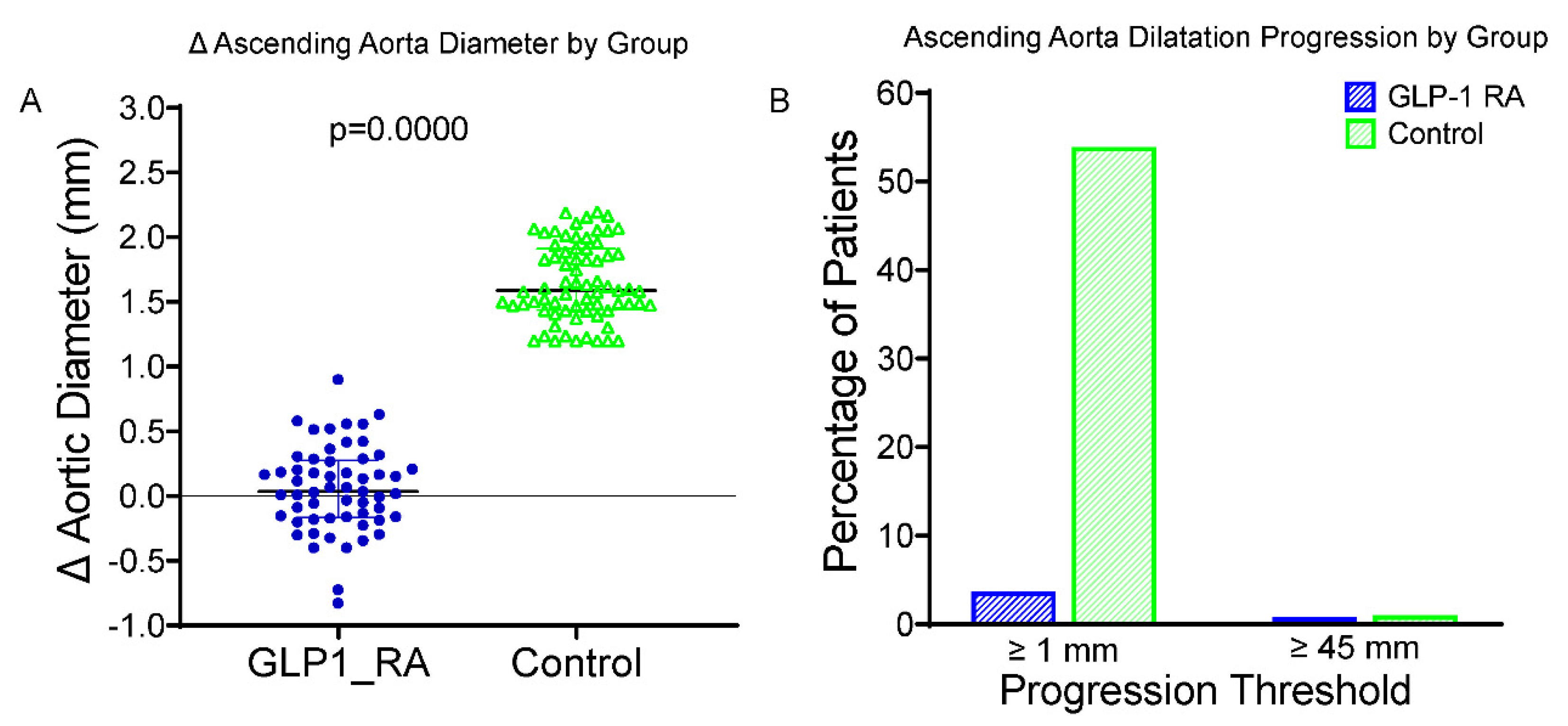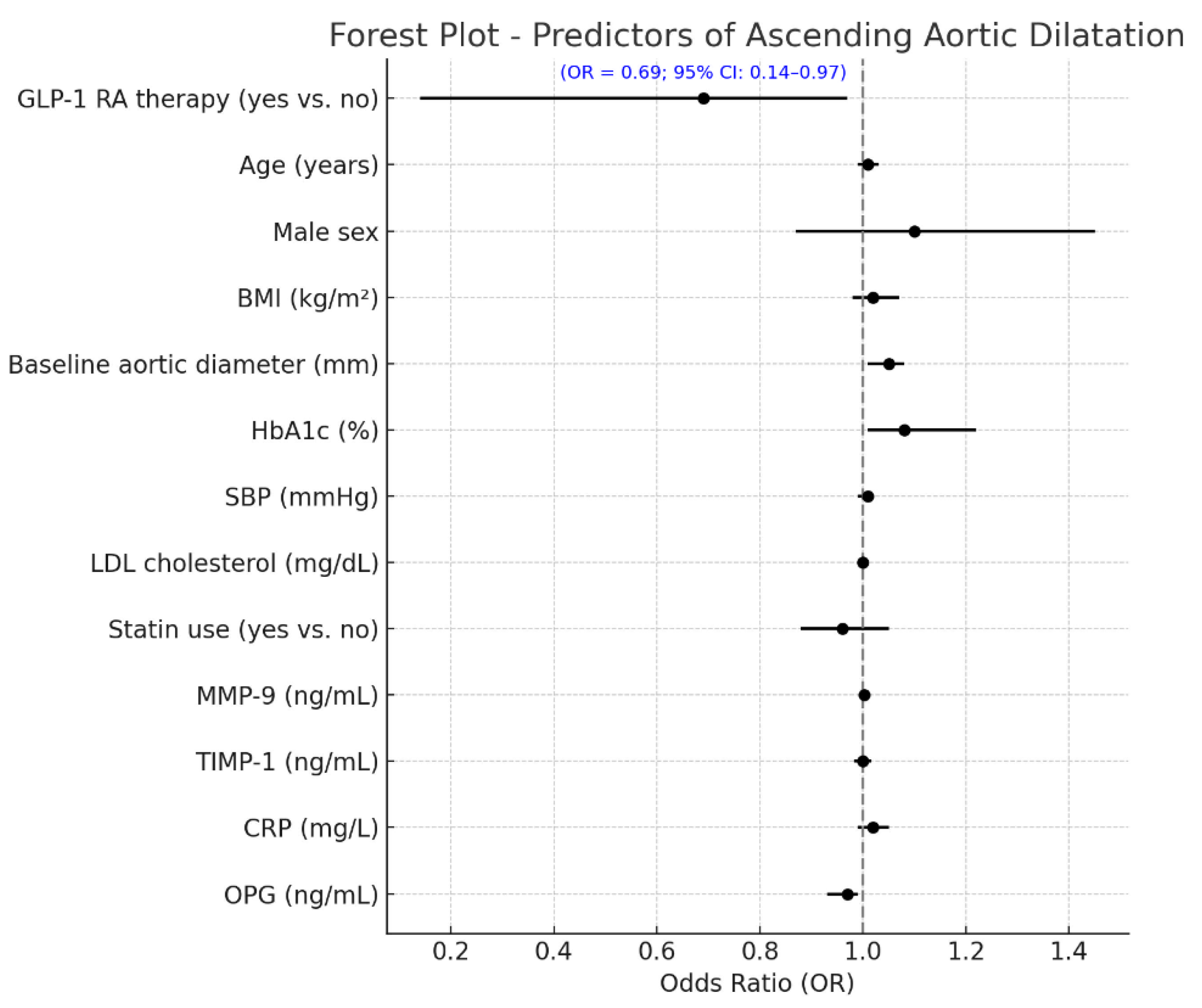GLP-1 Receptor Agonists Are Associated with Reduced Ascending Aorta Dilatation in Patients with Type 2 Diabetes: A Prospective Study
Abstract
1. Introduction
2. Results
2.1. Baseline Characteristics
2.2. Follow-Up Clinical Monitoring and Cardiometabolic Evolution
2.3. Circulating Biomarker Changes
2.4. Sensitivity Analyses
2.5. Cardiac Safety and Efficacy
3. Discussion
4. Methods and Materials
4.1. Study Population
4.2. Follow-Up and Clinical Evaluation
4.3. Imaging Protocol
4.4. Biomarker Analysis
4.5. Statistical Analysis
Author Contributions
Funding
Institutional Review Board Statement
Informed Consent Statement
Data Availability Statement
Conflicts of Interest
References
- Zhou, M.; Wang, X.; Li, J. Matrix metalloproteinase-9 expression in aortic aneurysms: A meta-analysis. J. Vasc. Surg. 2014, 59, 1355–1363. [Google Scholar]
- Newby, A.C. Metalloproteinase expression in monocytes and macrophages and its relationship to atherosclerotic plaque instability. Arterioscler. Thromb. Vasc. Biol. 2005, 25, 904–913. [Google Scholar] [CrossRef]
- Nakamura, M.; Yamamuro, A.; Nishikawa, H. Impact of ascending aortic dilatation on left ventricular afterload and remodeling in patients with hypertension. Hypertens. Res. 2012, 35, 915–921. [Google Scholar]
- Marso, S.P.; Daniels, G.H.; Brown-Frandsen, K.; Kristensen, P.; Mann, J.F.E.; Nauck, M.A.; Nissen, S.E.; Pocock, S.; Poulter, N.R.; Ravn, L.S.; et al. Liraglutide and cardiovascular outcomes in type 2 diabetes. N. Engl. J. Med. 2016, 375, 311–322. [Google Scholar] [CrossRef]
- Gerstein, H.C.; Colhoun, H.M.; Dagenais, G.R.; Diaz, R.; Lakshmanan, M.; Pais, P.; Probstfield, J.; Riesmeyer, J.S.; Riddle, M.C.; Rydén, L.; et al. Dulaglutide and cardiovascular outcomes in type 2 diabetes (REWIND): A double-blind, randomized placebo-controlled trial. Lancet 2019, 394, 121–130. [Google Scholar] [CrossRef] [PubMed]
- Marso, S.P.; Bain, S.C.; Consoli, A.; Eliaschewitz, F.G.; Jódar, E.; Leiter, L.A.; Lingvay, I.; Rosenstock, J.; Seufert, J.; Warren, M.L.; et al. Semaglutide and cardiovascular outcomes in patients with type 2 diabetes. N. Engl. J. Med. 2016, 375, 1834–1844. [Google Scholar] [CrossRef] [PubMed]
- Król, M.; Kupnicka, P.; Żychowska, J.; Kapczuk, P.; Szućko-Kociuba, I.; Prajwos, E.; Chlubek, D. Molecular Insights into the Potential Cardiometabolic Effects of GLP-1 Receptor Analogs and DPP-4 Inhibitors. Int. J. Mol. Sci. 2025, 26, 6777. [Google Scholar] [CrossRef] [PubMed]
- Arakawa, M.; Mita, T.; Azuma, K.; Ebato, C.; Goto, H.; Nomiyama, T.; Fujitani, Y.; Hirose, T.; Kawamori, R.; Watada, H. Inhibition of monocyte adhesion to endothelial cells and attenuation of atherosclerotic lesion by a GLP-1 receptor agonist, exendin-4. Diabetes 2010, 59, 1030–1037. [Google Scholar] [CrossRef] [PubMed]
- Liu, H.; Hu, Y.; Simpson, R.W.; Dear, A.E. Glucagon-like peptide-1 attenuates tumor necrosis factor-alpha-mediated induction of plasminogen activator inhibitor-1 expression. J. Endocrinol. 2008, 196, 57–65. [Google Scholar] [CrossRef] [PubMed]
- Tomas, E.; Habener, J.F. Insulin-like actions of glucagon-like peptide-1: A dual receptor hypothesis. Trends Endocrinol. Metab. 2010, 21, 59–67. [Google Scholar] [CrossRef] [PubMed]
- Sharma, A.K.; Lu, G.; Jester, J.V. Experimental abdominal aortic aneurysm formation is inhibited by exendin-4, a glucagon-like peptide-1 receptor agonist. Arterioscler. Thromb. Vasc. Biol. 2013, 33, 1671–1677. [Google Scholar]
- Kuzuya, M.; Satake, S.; Esaki, T. Circulating levels of matrix metalloproteinases and their inhibitors in patients with aortic aneurysm. J. Vasc. Surg. 2002, 36, 539–544. [Google Scholar]
- Golombek, S.; Doll, I.; Kaufmann, L.; Lescan, M.; Schlensak, C.; Avci-Adali, M. A Novel Strategy for the Treatment of Aneurysms: Inhibi-tion of MMP-9 Activity through the Delivery of TIMP-1 Encoding Synthetic mRNA into Arteries. Int. J. Mol. Sci. 2024, 25, 6599. [Google Scholar] [CrossRef] [PubMed]
- Wang, Y.; Aikawa, M.; Yang, Z. Osteoprotegerin promotes intimal plaque stability through inhibition of matrix metalloproteinases and proinflammatory cytokines. Arterioscler. Thromb. Vasc. Biol. 2005, 25, 2604–2609. [Google Scholar]
- Ridker, P.M.; Rifai, N.; Rose, L.; Buring, J.E.; Cook, N.R. Comparison of C-reactive protein and low-density lipoprotein cholesterol levels in the prediction of first cardiovascular events. N. Engl. J. Med. 2002, 347, 1557–1565. [Google Scholar] [CrossRef] [PubMed]
- Isselbacher, E.M.; Preventza, O.; Black, J.H., 3rd; Augoustides, J.G.; Beck, A.W.; Bolen, M.A.; Braverman, A.C.; Bray, B.E.; Brown-Zimmerman, M.M.; Chen, E.P.; et al. 2022 ACC/AHA Guideline for the Diagnosis and Management of Aortic Disease: A Report of the American College of Cardiology/American Heart Association Joint Committee on Clinical Practice Guidelines. Circulation 2022, 146, e334–e482. [Google Scholar] [CrossRef] [PubMed]
- Goldstein, S.A.; Evangelista, A.; Abbara, S.; Arai, A.; Asch, F.M.; Badano, L.P.; Bolen, M.A.; Connolly, H.M.; Cuéllar-Calàbria, H.; Czerny, M.; et al. Multimodality Imaging of Diseases of the Thoracic Aorta in Adults: From the American Society of Echocardiography and the European Association of Cardiovascular Imaging. J. Am. Soc. Echocardiogr. 2015, 28, 119–182. [Google Scholar] [CrossRef] [PubMed]
- Liu, H.; Dear, A.E.; Knudsen, L.B.; Simpson, R.W. A long-acting glucagon-like peptide-1 analogue attenuates induction of plasminogen activator inhibitor type-1 and vascular adhesion molecules. J. Endocrinol. 2009, 201, 59–66. [Google Scholar] [CrossRef] [PubMed]
- Battistoni, A.; Piras, L.; Tartaglia, N.; Carrano, F.M.; De Vitis, C.; Barbato, E. Glucagon-like peptide-1 receptor agonists and the endothelium: Molecular and clinical insights into cardiovascular protection. Front. Med. 2025, 12, 1669685. [Google Scholar] [CrossRef] [PubMed]
- Sardu, C.; Marfella, L.V.; Rinaldi, L.; Sasso, F.C.; Cozzolino, D.; Nappo, F.; Sellitto, A.; Romano, C.; Carusone, C.; D’Onofrio, N.; et al. Effects of combination therapy with SGLT2 inhibitors and GLP-1 receptor agonists on CRT response and clinical outcomes in in type 2 diabetes mellitus patients receiving chronic anti-diabetic medications: A multicenter observational study. Diabetes Res. Clin. Pract. 2025, 228, 112452. [Google Scholar] [CrossRef] [PubMed]



| Variable | GLP-1 RA Group (n = 57) | Control Group (n = 70) | p Value |
|---|---|---|---|
| Age, years | 63.4 ± 6.8 | 64.1 ± 7.0 | 0.48 |
| Male sex, n (%) | 36 (63.2%) | 44 (62.9%) | 0.97 |
| BMI, kg/m2 | 32.5 ± 3.2 | 28.1 ± 2.9 | <0.001 |
| Duration of diabetes, years | 10.1 ± 2.9 | 9.8 ± 3.1 | 0.57 |
| HbA1c, % | 8.4 ± 0.6 | 8.1 ± 0.7 | 0.03 |
| Systolic blood pressure, mmHg | 134 ± 11 | 136 ± 12 | 0.38 |
| Mean arterial pressure, mmHg | 98.4 ± 7.2 | 99.1 ± 6.9 | 0.61 |
| LDL cholesterol, mg/dL | 98.4 ± 13.7 | 96.7 ± 14.1 | 0.47 |
| eGFR, mL/min/1.73 m2 | 84.6 ± 12.5 | 86.1 ± 11.8 | 0.37 |
| eGFR ≥ 90, n (%) | 20 (35.1%) | 27 (38.6%) | 0.71 |
| eGFR 60–89, n (%) | 34 (59.6%) | 39 (55.7%) | 0.68 |
| eGFR < 60, n (%) | 3 (5.3%) | 4 (5.7%) | 0.92 |
| Hypertension, n (%) | 43 (75.4%) | 52 (74.3%) | 0.88 |
| Dyslipidemia, n (%) | 40 (70.2%) | 51 (72.9%) | 0.72 |
| History of cardiovascular disease, n (%) | 11 (19.3%) | 13 (18.6%) | 0.92 |
| Statin use, n (%) | 43 (76.1%) | 55 (78.6%) | 0.73 |
| ACEi/ARB use, n (%) | 38 (66.7%) | 49 (70.0%) | 0.69 |
| Beta-blocker use, n (%) | 19 (33.3%) | 25 (35.7%) | 0.78 |
| Antiplatelet therapy, n (%) | 21 (36.8%) | 26 (37.1%) | 0.97 |
| Metformin use, n (%) | 51 (89.5%) | 65 (92.9%) | 0.52 |
| SGLT2i use, n (%) | 17 (29.8%) | 14 (20.0%) | 0.21 |
| Insulin use, n (%) | 13 (22.8%) | 15 (21.4%) | 0.85 |
| Aortic arch diameter, mm | 38.3 ± 2.4 | 38.1 ± 2.2 | 0.48 |
| Parameter | GLP-1 RA Group Baseline | GLP-1 RA Group 24 mo | p (Within Group) | Control Group Baseline | Control Group24 mo | p (Within Group) | p (Between Groups at 24 mo) |
|---|---|---|---|---|---|---|---|
| BMI, kg/m2 | 32.5 ± 3.2 | 29.6 ± 3.0 | <0.001 | 28.1 ± 2.9 | 27.9 ± 3.0 | 0.22 | <0.001 |
| HbA1c, % | 8.4 ± 0.6 | 7.1 ± 0.5 | <0.001 | 8.1 ± 0.7 | 7.2 ± 0.5 | <0.001 | 0.047 |
| MAP, mmHg | 98.4 ± 7.2 | 91.5 ± 6.7 | 0.002 | 99.1 ± 6.9 | 90.8 ± 6.8 | <0.001 | 0.78 |
| LDL cholesterol, mg/dL | 98.4 ± 13.7 | 86.1 ± 11.9 | <0.001 | 96.7 ± 14.1 | 90.6 ± 12.3 | 0.012 | 0.041 |
| Aortic ascending diameter, mm | 38.3 ± 2.4 | 38.7 ± 2.5 | <0.001 | 38.1 ± 2.2 | 39.2 ± 2.3 | <0.001 | <0.001 |
| MMP-9, ng/mL | 556.2 ± 123.4 | 421.1 ± 113.2 | <0.001 | 558.8 ± 124.4 | 570.2 ± 141.8 | 0.04 | <0.001 |
| TIMP-1, ng/mL | 161.4 ± 33.7 | 175.5 ± 34.7 | 0.003 | 156.7 ± 34.4 | 160.4 ± 18.2 | 0.31 | 0.005 |
| CRP, mg/L | 4.1 ± 1.2 | 2.8 ± 0.7 | <0.001 | 3.9 ± 1.2 | 4.2 ± 1.3 | 0.11 | <0.001 |
| OPG, ng/mL | 3.9 ± 0.9 | 4.9 ± 0.8 | 0.002 | 3.7 ± 0.6 | 3.8 ± 0.6 | 0.21 | 0.004 |
| Variable | β Coefficient | 95% CI | p Value |
|---|---|---|---|
| GLP-1 RA therapy (yes vs. no) | −0.72 | (−0.94 to −0.51) | <0.001 |
| Age (years) | +0.010 | (−0.004 to +0.024) | 0.16 |
| Male sex | +0.092 | (−0.074 to +0.258) | 0.27 |
| BMI (kg/m2) | +0.014 | (−0.007 to +0.035) | 0.19 |
| Baseline aortic diameter (mm) | +0.046 | (+0.017 to +0.075) | 0.004 |
| HbA1c (%) | +0.081 | (+0.018 to +0.144) | 0.015 |
| Systolic BP (mmHg) | +0.005 | (−0.002 to +0.013) | 0.13 |
| LDL cholesterol (mg/dL) | +0.001 | (−0.004 to +0.006) | 0.72 |
| Statin use (yes vs. no) | −0.039 | (−0.185 to +0.108) | 0.60 |
| MMP-9, ng/mL | +0.004 | (+0.001 to +0.006) | 0.001 |
| TIMP-1, ng/mL | −0.006 | (−0.010 to −0.002) | 0.008 |
| CRP, mg/L | +0.020 | (−0.006 to +0.046) | 0.13 |
| OPG, ng/mL | −0.028 | (−0.056 to −0.001) | 0.043 |
Disclaimer/Publisher’s Note: The statements, opinions and data contained in all publications are solely those of the individual author(s) and contributor(s) and not of MDPI and/or the editor(s). MDPI and/or the editor(s) disclaim responsibility for any injury to people or property resulting from any ideas, methods, instructions or products referred to in the content. |
© 2025 by the authors. Licensee MDPI, Basel, Switzerland. This article is an open access article distributed under the terms and conditions of the Creative Commons Attribution (CC BY) license (https://creativecommons.org/licenses/by/4.0/).
Share and Cite
Sardu, C.; Marfella, L.V.; Fumagalli, C.; Rinaldi, L.; Sasso, F.C.; Cozzolino, D.; Nappo, F.; Sellitto, A.; Romano, C.; Carusone, C.; et al. GLP-1 Receptor Agonists Are Associated with Reduced Ascending Aorta Dilatation in Patients with Type 2 Diabetes: A Prospective Study. Int. J. Mol. Sci. 2025, 26, 9977. https://doi.org/10.3390/ijms26209977
Sardu C, Marfella LV, Fumagalli C, Rinaldi L, Sasso FC, Cozzolino D, Nappo F, Sellitto A, Romano C, Carusone C, et al. GLP-1 Receptor Agonists Are Associated with Reduced Ascending Aorta Dilatation in Patients with Type 2 Diabetes: A Prospective Study. International Journal of Molecular Sciences. 2025; 26(20):9977. https://doi.org/10.3390/ijms26209977
Chicago/Turabian StyleSardu, Celestino, Ludovica Vittoria Marfella, Carlo Fumagalli, Luca Rinaldi, Ferdinando Carlo Sasso, Domenico Cozzolino, Francesco Nappo, Ausilia Sellitto, Ciro Romano, Caterina Carusone, and et al. 2025. "GLP-1 Receptor Agonists Are Associated with Reduced Ascending Aorta Dilatation in Patients with Type 2 Diabetes: A Prospective Study" International Journal of Molecular Sciences 26, no. 20: 9977. https://doi.org/10.3390/ijms26209977
APA StyleSardu, C., Marfella, L. V., Fumagalli, C., Rinaldi, L., Sasso, F. C., Cozzolino, D., Nappo, F., Sellitto, A., Romano, C., Carusone, C., Russo, P., Marfella, L., Tarantino, N. M., Carpinella, G., Furbatto, F., Gentile, S., Guarino, G., Satta, E., Bellis, A., ... Marfella, R. (2025). GLP-1 Receptor Agonists Are Associated with Reduced Ascending Aorta Dilatation in Patients with Type 2 Diabetes: A Prospective Study. International Journal of Molecular Sciences, 26(20), 9977. https://doi.org/10.3390/ijms26209977










